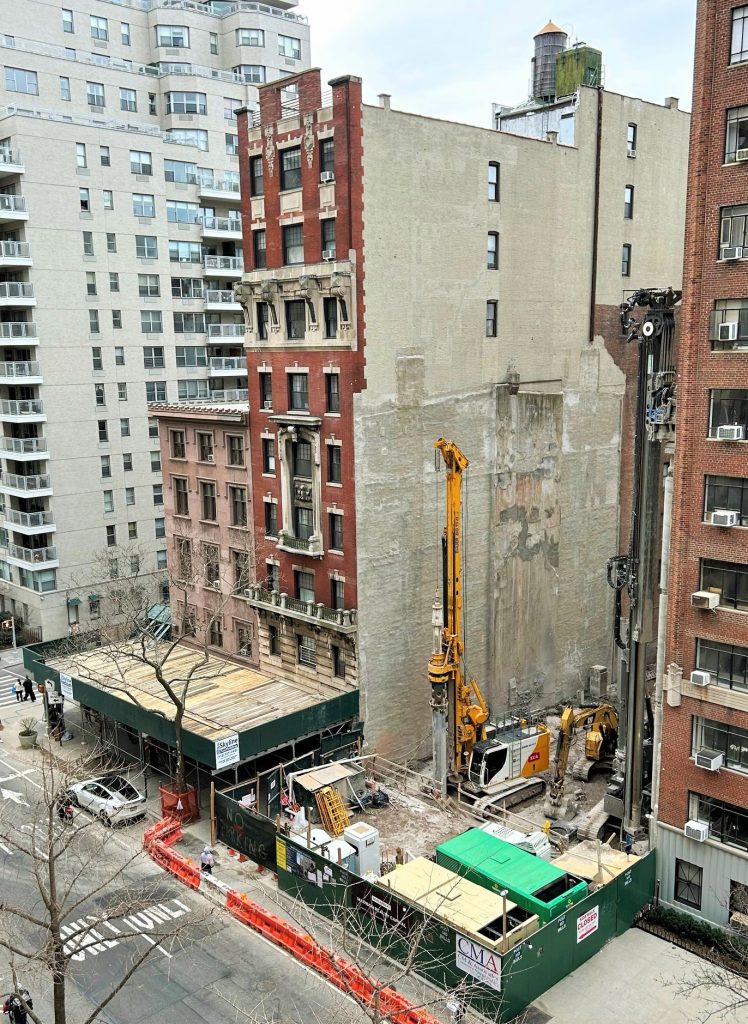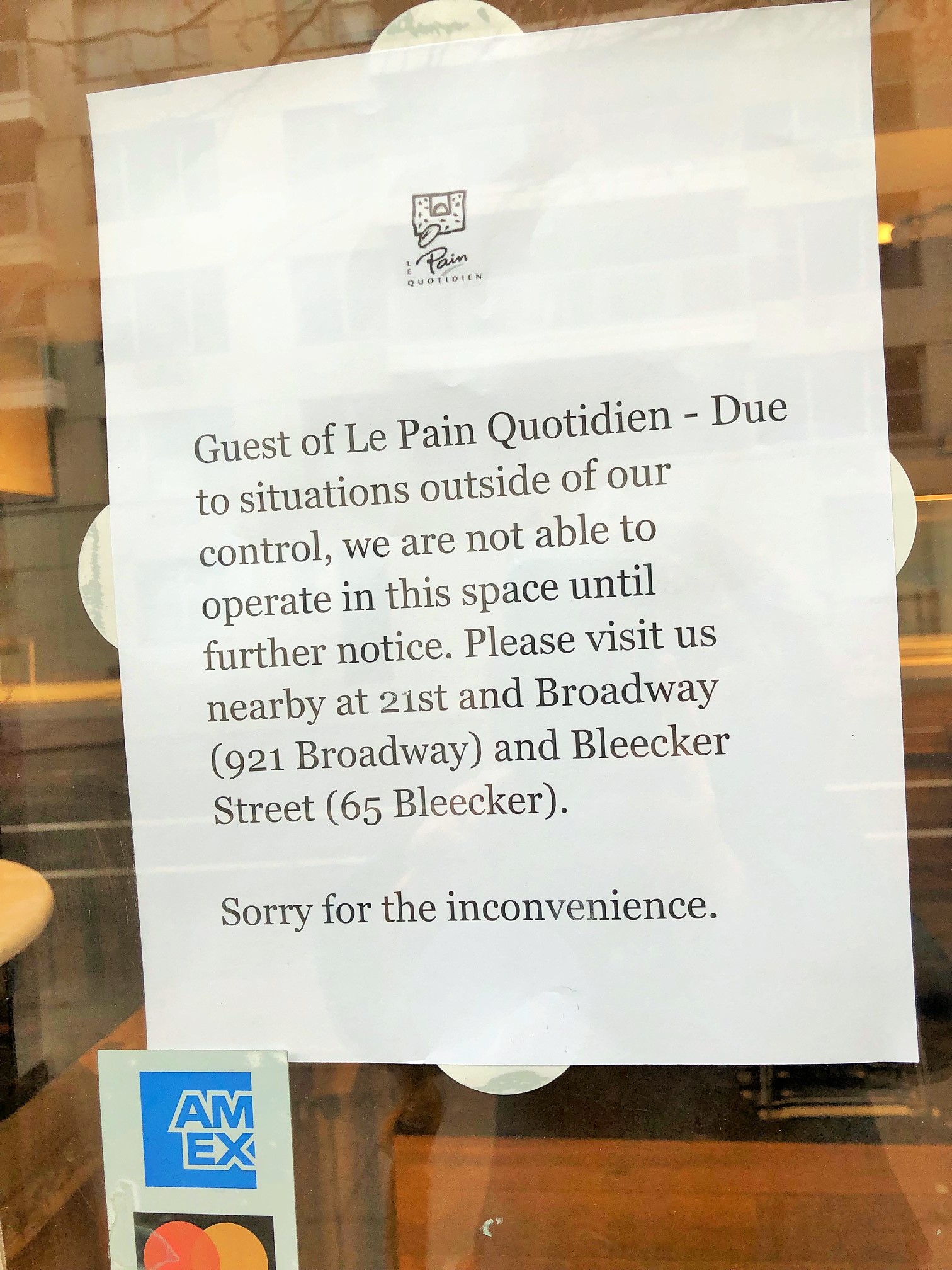BY LINCOLN ANDERSON | Following Saturday’s latest construction-caused crisis in Greenwich Village — this time at Eighth Street and Fifth Avenue — word is that the Department of Buildings has not ordered the evacuation of a second historic building — despite the fact that the structure alarmingly showed “signs of movement.”
As of early Monday afternoon, the online D.O.B. Buildings Information System did not show any updates for 12 Fifth Ave., still only saying that the 10-story property is “under structural monitoring.”
On the other hand, D.O.B. on Saturday issued an emergency vacate order for the neighboring five-story building at 10 Fifth Ave. after, earlier that morning, large cracks opened on its facade and some of its window lintels shockingly spread apart several inches in their middle. The order warns that entering the building is “imminently perilous to life.”
Local resident Marguerite Martin went by the construction-rattled site early Monday morning and said workers at the scene told her that No. 12 “was safe” but that No. 10 still has a vacate order in effect.

In addition to the corner building’s 14 residential apartments, its commercial storefronts are also subject to the emergency vacate order. Unfortunately, for local croissant cravers, that includes the popular Le Pain Quotidien bakery.
Andrew Berman, executive director of Village Preservation, reported that the latest he is hearing from D.O.B. is that emergency shoring up is required at the site to brace at-risk support walls.
“No. 10 Fifth Ave. requires shoring,” he said. “Nos. 10 and 12 share a party wall, and their party wall will be shored, as well. A stop-work order remains in effect for 14-16 Fifth Ave. As of right now, an evacuation order is in effect only for No. 10.”
Ever since the scheme was first proposed several years ago, Berman and Village Preservation had vehemently opposed the plan for a new, high-rise, sliver tower at 14-16 Fifth Ave., which is within the Greenwich Village Historic District. Madison Capital Realty’s project required demolition of two landmarked, low-rise apartment buildings that had been combined into one, whose former residents included some of New York’s most elite names.
Nevertheless, the city’s Landmarks Preservation Commission O.K.’d the high-end condo project. The historic buildings have since been demolished and work on the foundation for the new luxury tower has been underway for some months now.
The site sits right atop a bend in the legendary, long-since-buried Minetta Creek. (One theory of the name is that “Minetta” means “devil’s water” in the native Lenape tongue.) To provide a firmer foundation, the developers are using two giant foundation drills to dig shafts into the ground for support piles. A backhoe-like excavator machine is also being used at the site, which sits one block north of Washington Square Park on the exclusive stretch of Lower Fifth Avenue.


This newspaper should revisit the site and publish photos of the shoring up of the building next to the site. The amount of steel and the apparatus is truly terrifying.
This epitomizes the strangehold that real estate has on NYC & is yet another epic fail by the NYC Landmarks Commission. Not only should the LPC NEVER have un-designated those historic buildings — in a historic neighborhood! — but the “approved” new building is completely out of context on 5th Ave in the Village. And worse, clearly unsafe to install.
Shame on you Landmarks Preservation Commission. You are a joke, You are worthless. Hang your heads in shame. What good is having a Historic District if you ignore the designation? You may as well disband for all the preservation you (don’t) preserve.
Why, oh why, was it necessary to even consider building the sliver and destroying the nature of the historic neighborhood? The mind boggles to conceive and understand how approval for this sliver was given. The approval raises many questions about those who made the decision and how their recklessnes will be paid for, by them… .
When I owned a building on Watts Street it was severely damaged by pile drilling for a new hotel on the adjacent property. Prior to the start of construction, I hired an engineer to review the plans and he told me I was lucky they were doing it right and drilling piles instead of driving them. Because the noise and vibration are less, people assume drilling is safe. It is better than driving the piles, but here’s the problem: As the drill cuts a hole through soil and rock, the material has to be removed. This is accomplished by washing the debris up to the surface through a pipe inside the pile using lots of water under very high pressure. All is good until the drill hits loosely packed soil, which is not uncommon on a site where a building has just been demolished. Then the pressurized water goes into the ground instead of up the pipe and large amounts of soil can be washed away in a short time. If this happens near an older building, its foundation can be undermined. The control to prevent this is only the operator of the drilling equipment, who is supposed to shut it down quickly when a blow-out or wash-out is detected. This happens very suddenly and the response has to be quick. The lack of better control of the process is a significant shortcoming of the building code with regard to pile drilling adjacent to older buildings and is an ongoing threat to the safety of residents and the protection of property and historic areas.
As for the drilling process itself, the pile is a big pipe that eventually gets filled with concrete. The end of the pipe has stone cutting teeth on it, so it acts as a drill that gets left in the ground. Another smaller pipe that also has a drill bit on the end is inside the bigger pipe. As both pipes turn, high-pressure water is forced down through the small pipe and that pushes the debris up through the space between the two pipes. When they hit bedrock, they continue a certain distance and then withdraw the smaller pipe, including the drill bit on the end. They then force concrete down into the bigger pipe and that becomes the pile. As stated above, all is well and good unless the two pipes hit a void or an area of loose soil, in which case the high-pressure water is released into the ground, washing away soil. It is not uncommon that older foundations have loose soil under them, so the operator has to carefully monitor the process, especially when working next to older buildings. If the pipes slip down suddenly, they have to quickly shut off the water.
Very informative. One complicating factor is that Minetta Brook flows underground just beneath all these buildings. Perhaps the drilling (with or without water) disturbed the flow of the brook, for the first time in more than a century, which in turn undermined the foundation of 10 Fifth?
Of course, everyone involved, the developer, contractors, LPC, DOB, etc. were well aware of Minetta Brook.
Capital has it figured out, tear down two and two more fall down.
This is truly heartbreaking. How can the LPC ever have approved a high-rise silver tower in the heart of historic Greenwich Village?
the LPC is a sham organization
This building should never have been approved.